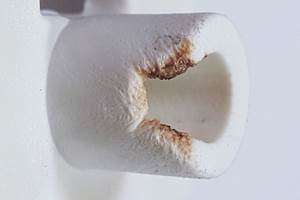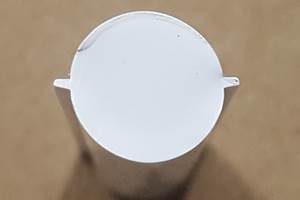Hot/Cold Thermal Cycling of Injection Molds Heats Up
Injection molders are warming up to the idea of cycling their tool surface temperature during the molding cycle rather than keeping it constant.
Injection molders are warming up to the idea of cycling their tool surface temperature during the molding cycle rather than keeping it constant. This “heat/cool” process has caught on faster abroad, but more U.S. molders are now also finding that raising the mold wall temperature above the resin’s glass-transition or crystalline melting temperature during the filling stage, followed by rapid cooling, brings a bevy of benefits in processability and product performance in applications from automotive to packaging to optics.
Processing benefits include longer, more uniform holding pressure, even in areas far from the gate, which can lower injection pressure and clamping requirements; improved flow lengths; reduction of internal part stresses; and reduction or elimination of weld lines, jetting, silver streaks, or sink marks. Other significant benefits are improved replication of minute mold-surface details and improved part surface finish. For example, it reportedly can ensure a smooth, resin-rich surface in glass-reinforced parts or prevent visible bubbles or “splay” in foamed parts. Thermal cycling of the mold can eliminate post-mold downstream operations such as sanding, annealing, priming, and painting to hide surface defects. At least one supplier says it is used to initiate chemical curing reactions in the mold. Heat/cool molding is being increasingly considered for thin-wall applications due to the reduced filling pressure and injection pressure requirements. Parts down to 0.4 mm have already been molded using the process.
Dynamic mold-temperature cycling has been used for flat parts, complex shapes, and large or small parts. Heat/cool, or variable-temperature molding is often called “Variotherm” molding, a term coined and trademarked by Werkzeugbau Siegfried Hofmann GmbH in Lichtenfels, Germany (hofman-wzb.de). The process has several different variants. It is not for every application, yet because suppliers are making the process more efficient and easier to implement, it is finding an increasing diversity of applications from automotive bumpers to television flat-screen frames, cellphone cases, laptop covers, automotive lenses, and niche areas such as lab-on-chip devices with molded micro-capillary structures.
Early successes in commercializing the various heat/cool technologies are being driven mostly by firms in Germany or France, including Hofmann, Single Temperiertechnik GmbH, Gesellschaft Warme Kalttechnik mbH (GWK), RocTool, Wittmann Battenfeld, and Engel. The different approaches add complexity to the tool, and usually require a temperature sensor in the mold that gives a signal to the injection press or temperature controller. Newer approaches decouple the heating and cooling phases, which allows for mold-temperature increases as rapid as 25° C/sec. Several of the processes enhance cooling by incorporating thermally conductive inserts and/or conformal cooling channels that follow the contours of the part more closely than traditional gun-drilled straight channels.
Molders can raise the temperature of their mold surface using various means:
- Convection heating with water or oil through single or multiple heat/cool circuits in the tool. Hot dry air or steam is also used—turned on and off during injection/cooling. (Steam is being used mainly by developers in Japan.)
- Conduction (using electric or ceramic heating cartridges in the mold).
- Induction by means of an inductor that generates an alternating electromagnetic field. Inductors can be integrated into the mold or built in a “cage” surrounding the mold.
- Radiation from infrared lamps.
CONDUCTION SUCCESSES
GWK, a maker of mold-temperature-control and cooling equipment in Kierspe, Germany (gwk.com), says its Dynamic Mold Temperature Control has been used for many heat/cool applications. Its dynamic Mold Temperature Control process is a combination of high-density ceramic heaters (800W/in.2) mounted just below the tool surface and conformal cavity and core cooling channels. In thin mold sections that cannot accommodate conformal cooling, GWK uses thermally conductive inserts that extend back to the cooling channels. These approaches reportedly can heat at 30° C/sec and cool at 10° C/sec. Temperatures with this process range from 41 F to 750 F says Peter Lipp, operations manager for YellowBox Technologies, LLC, Union Ky. (yellowboxengineering.com), representing GWK in the USA and Canada.
GWK’s system was used in the production of a 500-ml PP container molded in two cavities. The higher mold temperature improved melt flow into the mold, which reduced holding and clamping pressure. Cycle time was cut 35% from 4.2 sec to 2.7 sec, with cooling time trimmed from 2.8 sec to 1.4 sec. Productivity increased 55%, says Lipp. GWK’s process is also used for polycarbonate LED focusing lenses for auto headlamp assemblies, which have component structures ranging from 0.5 mm to 14 mm thick. A recent application involves back-injecting 30% glass-filled PC/ABS onto aluminum foil, where raising the mold temperature prior to injection activates the chemical adhesive and improves material flow. Conformal cooling (GWK’s “Integrat 4D” system) reduced the overall cycle by 40%.
Lipp says nano-structures on optical parts, which require exact replication of the tool surface, is a growing area of demand for this process. Molding functional surfaces for medical applications is a development focus, too.
INDUCTION ARRIVES
RocTool innovative Molding Technologies, Le Bourget du Lac, France (newly represented here by RocTool North America, Atlanta, roctool.com) offers two induction technologies for heat/cool injection molding and already has 20 licenses globally, three of them in North America, says Mathieu Boulanger, business development manager. Last October, RocTool acquired the rights to the Indumold induction process, which embeds inductors in the mold, from the German Plastics Institute (Kunststoff Institut Ludenscheid). RocTool renamed that process 3iTech (Integrated Internal Induction Technologies). It joins RocTool’s Cage induction process (in which a “cage” of inductors surrounds the tool) under its Heat & Cool solutions for injection molders. Boulanger says the two approaches deliver rapid heating up to 25° C /sec and cooling as fast as 15° C /sec. A temperature sensor in the tool signals a change to the mold temperature.
RocTool’s latest development targets high-temperature resins like PEEK. To mold a 900-g PEEK part measuring 60 x 50 cm x 2.2 mm thick, the tool was heated to 330 C (626 F), allowing a single gate to deliver flow lengths of 400 mm (vs. 200 mm at 180 C mold temp) while minimizing the weld line. The company is currently working with a molder on a thin-walled injection molded part for an aerospace application.
In 2008, Wittmann Battenfeld in Austria (Wittmann, Inc., Torrington, Conn., wittmann-battenfeld.com) collaborated with the Plastics Institute of Ludenscheid in the development of the original “Variothermal Tempering” induction process before it was renamed Indumold and sold to RocTool. Wittmann Battenfeld showed how the process could be used to mold thick-walled parts that require a high-gloss surface, even when a chemical foaming agent is used. At the Fakuma 2008 show in Germany, Wittmann Battenfeld produced a bottle opener molded from ABS that was foamed to prevent sink marks and warpage. Induction heating on the front side of the part yielded excellent gloss, while the unheated back side had a rough, marbled surface and flow marks typical of conventionally molded parts. The inductor built into the mold heated the cavity to 625 F in 6 sec, followed by 25 sec of cooling at 68 F through conformal channels. Wittmann Battenfeld is currently developing two new heat/cool approaches of its own.
CONVECTION IN ACTION
Single in Germany (U.S. office is Single Temperature Controls Inc., Charlotte, N.C., single-temp.com), a maker of chillers and hot-water or oil mold-temperature controllers, is actively promoting heat/cool technology. Its Alternating Temperature Technology (ATT) approach delivers heated or cooled water or oil to the mold alternately through a single circuit. Single also offers EcoTemp, a less expensive approach whereby only cooling is supplied to the mold, but circulation is interrupted at the start of the cycle, allowing the cavity wall to be heated by the incoming resin, followed by an intense cooling phase. Both ATT and EcoTemp systems have a stand-alone control. The ATT system can deliver water at up to 400 F, but a prototype system delivers oil at up to 575 F. EcoTemp was introduced last year for the lens market, where it helps reduce molded-in stresses. It uses lower media temperature than conventional cooling at a constant temperature. Single also offers conductive mold inserts with conformal cooling channels.
Automotive has been one area of interest. A system was developed for Visteon to mold a roof rack of PC/ABS. “Molding cycle time increased from 35 sec to 55 sec, but the excellent part surface eliminated sanding, painting, and annealing required previously,” says Michael Bloomhuff, U.S. national sales manager. Single also worked on a roof-rack rail-support bracket with Sabic Innovative Plastics, Pittsfield, Mass. (sabic-ip.com). It used an 11% glass-filled Xenoy PC/PBT resin. Potential problems of jetting, weld-line visibility, or a rough surface requiring post mold sanding were eliminated. Sabic has two Single systems at its Polymer Processing Development Center in Pittsfield.
Gas Injection Worldwide Ltd., Middlewich, Cheshire, U.K. (gasinjection-ww.com) developed its Rapid Temperature Cycling (RTC) process four years ago. One version, RTC SWC (Steam Heating Water Cooling) technology targets large parts with complex 3D geometry, while its RTC IHC (Induction Heating Control) system is suited to smaller, 2D shapes, says Raymond Foad, sales director. GIWW has several dozen applications in commercial production. Its first commercial success was use of RTC SWC by several molders producing LCD flat-screen TV frames. Automotive is the new frontier. “No visible weld lines, no surface splay marks on foamed parts, and up to 40% reduction in filling pressures, make the technology of immense importance to global automotive suppliers,” says Foad. For automotive applications, GIWW developed its Dedicated Steam Generator, a mobile electric boiler system able to supply steam to two injection presses. GIWW also partnered recently with the CYC University in Taiwan, which developed an external induction heating system that GIWW calls RTC IHC and can be used on existing tooling. The process uses a special handling device to bring a copper induction coil within 3 to 5 mm of the surface of the open mold. The IHC system can heat the mold surface by 150° C in 3 to 5 sec. Its first commercial RTC IHC application started up in January. “A large European Tier 2 supplier of metalized parts was experiencing high scrap rates due to weld lines and flow marks on an ABS/PC auto interior bezel. Using RTC IHC technology to eradicate the weld lines and flow marks, the customer has virtually eliminated scrap for this part,” reports Foad.
AHEAD FOR INFRARED
Engel (U.S. office in York, Pa., (engelglobal.com/na) unveiled its Variomelt IR-based concept at K 2007 that can heat the mold by 10 to 13° C/sec. It was used to produce a cellphone shell with a “piano black” surface. The high mold temperature during injection greatly increased surface gloss, and an unavoidable weld line was rendered invisible. For IR to work efficiently, the absorption of the tool surface to be heated must be increased, and the amount of dynamically heated mass must be minimized. The newest version of Variomelt fixes the IR heater atop the mold, rather than having the heater move into the mold area during mold opening. The new approach features an indexing plate with a hydraulically driven rack and pinion. While injection takes place in the bottom cavity, a finished part is removed from the top cavity, which is outside the mold. After part removal, the top cavity is heated by the mold-mounted heater behind the cavity. As a result heating takes place in parallel and does not form part of the cycle time. Also, no device is needed to manipulate the heater, as in the earlier version. Engel says the concept is energy efficient because a very small mass (just the insert) is heated. The fixed IR element heats the indexing cavity from the back side, which can remain rough for better IR absorption than a polished mold surface. Thus, no special coating is required.
Related Content
Back to Basics on Mold Venting (Part 1)
Here’s what you need to know to improve the quality of your parts and to protect your molds.
Read MoreWhere and How to Vent Injection Molds: Part 3
Questioning several “rules of thumb” about venting injection molds.
Read MoreHow to Select the Right Tool Steel for Mold Cavities
With cavity steel or alloy selection there are many variables that can dictate the best option.
Read MoreTunnel Gates for Mold Designers, Part 1
Of all the gate types, tunnel gates are the most misunderstood. Here’s what you need to know to choose the best design for your application.
Read MoreRead Next
Lead the Conversation, Change the Conversation
Coverage of single-use plastics can be both misleading and demoralizing. Here are 10 tips for changing the perception of the plastics industry at your company and in your community.
Read MoreHow Polymer Melts in Single-Screw Extruders
Understanding how polymer melts in a single-screw extruder could help you optimize your screw design to eliminate defect-causing solid polymer fragments.
Read More









.png;maxWidth=300;quality=90)



















